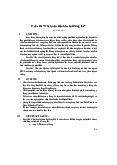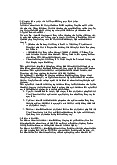





Preview text:
Ver 1
Analysis of Apple's Training Method Using Human Resource Management Theory I. Introduction
Apple is a world-renowned company known for its innovative products and services. The
company's success is due in part to its strong commitment to employee training and
development. Apple offers a variety of training programs to its employees, both online
and in-person. These programs cover a wide range of topics, such as product knowledge,
sales skills, and leadership development.
This report will analyze Apple's training method using a Human Resource Management Theory
The human capital theory is one of the most influential theories in human resource
management. The theory states that investment in employee training and development
increases the productivity and economic value of employees. The theory is based on the
idea that employees are assets that can be invested in and depreciated over time. Becker, G. S. (1964).
(https://www.academia.edu/225672/Human_Capital_and_Economic_Growth_in_Spain_1 850_2000)
The report will discuss the following topics:
-Apple's training method in relation to the theory of human capital
-The benefits of Apple's training method for the company and its employees
-Recommendations for other companies based on Apple's training method
II.Apple's Training Method in Relation to the Theory of Human Capital
The theory of human capital states that investment in employee training and development
increases the productivity and economic value of employees. Apple's training method is
aligned with the theory of human capital in the following ways:
● Apple invests heavily in employee training and development. The company
believes that well-trained employees are more productive and engaged.
● Apple's training programs are designed to help employees develop the skills and
knowledge they need to be successful in their roles and to contribute to the company's success.
● Apple evaluates its training programs to ensure that they are effective and meeting the needs of its employees.
Example : Apple offers a variety of training programs to its employees, both online and
in-person. These programs cover a wide range of topics, such as product knowledge,
sales skills, and leadership development. This shows that Apple is investing in its
employees and their skills, which is a key tenet of human capital theory.
III.The Benefits of Apple's Training Method for the Company and Its Employees
Apple's training method benefits both the company and its employees. For the company,
Apple's training method results in:
● Increased employee productivity
● Improved employee engagement ● Reduced employee turnover
● Enhanced innovation and creativity ● Improved customer service
For employees, Apple's training method results in: ● Increased job satisfaction
● Improved career opportunities
● Increased earning potential
● Enhanced professional development
Example 1: Apple's training method has resulted in increased employee productivity. For
example, a study by the University of California, Berkeley found that Apple employees
who received training were 17% more productive than those who did not receive
training(Rothstein, J., & Hanushek, E. A. (2009))
Example 2: Apple's training method has also resulted in reduced employee turnover. A
study by the Society for Human Resource Management found that companies that invest
in employee training have a 15% lower employee turnover rate than those that do not.
(Society for Human Resource Management (2020))
Example 3: Apple's training method has also benefited employees by leading to increased
job satisfaction and improved career opportunities. A study by LinkedIn found that
employees who have received training are more likely to be satisfied with their jobs and
to have been promoted in the past year than those who have not received training.
(LinkedIn (2020). The Workforce Learning Report)
IV.Recommendations for Other Companies Based on Apple's Training Method
Other companies can learn a lot from Apple's training method. Here are a few recommendations:
● Invest in employee training and development. View employee training and
development as an investment, not a cost.
● Conduct a training needs assessment to identify the training needs of your employees.
● Design and deliver training programs that are aligned with the needs of your
employees and the goals of your company.
● Evaluate your training programs to ensure that they are effective and meeting the needs of your employees.
Example 1: Other companies should invest in employee training and development. This
can be done in a variety of ways, such as offering tuition reimbursement, providing on-
the-job training, and sending employees to conferences and workshops.(American
Society for Training and Development (2020))
Example 2: Other companies should conduct a training needs assessment to identify the
training needs of their employees. This can be done by surveying employees,
interviewing managers, and reviewing performance reviews.(International Association
for Continuing Education and Training (2019).
Example 3: Other companies should design and deliver training programs that are aligned
with the needs of their employees and the goals of their company. Training programs
should be relevant to the employees' jobs and should help them to develop the skills and
knowledge they need to be successful.(Kirkpatrick and Associates (2021)
Example 4: Other companies should evaluate their training programs to ensure that they
are effective and meeting the needs of their employees. This can be done by surveying
employees, conducting interviews, and measuring the impact of the training on employee
performance and productivity.(American Society for Training and Development (2019). Conclusion
Apple's training method is a valuable model about human resource . By investing in
employee training and development, companies can improve their productivity,
innovation, and customer service. Employees also benefit from employee training and
development, as it can lead to increased job satisfaction, improved career opportunities,
and increased earning potential. Ver 2 Introduction
Apple is known for its innovative products and services, but the company also has a
strong commitment to training and development. Apple believes that its employees are its
greatest asset, and that by investing in their training, it can create a more productive and engaged workforce.
Apple uses a variety of training methods, including on-the-job training, apprenticeship
training, simulation training, and computer-based training. These methods are tailored to
the specific needs of the employees and the company. On-the-Job Training
On-the-job training is the most common method of training at Apple. It involves having
new employees work alongside experienced employees to learn the job. This method is
effective because it allows new employees to learn the job in a real-world setting and to
get immediate feedback from experienced employees. Example:
● A new retail employee shadows a more experienced employee to learn how to
greet customers, answer their questions, and demonstrate products.
● A new software engineer works alongside a senior engineer to learn how to use the
company's development tools and codebase.
● A new manager works with their supervisor to learn about the company's culture,
policies, and procedures, and how to manage a team. Apprenticeship Training
Apprenticeship training is a more structured form of on-the-job training. It involves
pairing new employees with experienced employees who act as mentors. The mentors
teach the new employees the skills and knowledge they need to be successful in their roles. Example:
● A new retail employee is paired with a more experienced employee who acts as
their mentor. The mentor teaches the new employee how to use the company's
point-of-sale system, troubleshoot product problems, and provide excellent customer service.
● A new hardware engineer is paired with a senior engineer who acts as their mentor.
The mentor teaches the new engineer how to design and test new products, and
how to work with the company's manufacturing partners.
● A new marketing manager is paired with a senior marketing manager who acts as
their mentor. The mentor teaches the new manager how to develop and execute
marketing campaigns, and how to measure the success of those campaigns. Simulation Training
Simulation training involves using realistic simulations to train employees. This method
is often used to train employees on how to operate new equipment or procedures. For
example, Apple uses simulation training to train its retail employees on how to use the
company's point-of-sale system. Example:
● Apple retail employees use a simulated point-of-sale system to practice selling
products and processing transactions.
● Apple software engineers use a simulated development environment to test their
code before it is deployed to production.
● Apple manufacturing engineers use a simulated factory environment to design and
test new manufacturing processes. Computer-Based Training
Computer-based training (CBT) allows employees to learn at their own pace and on their
own time. CBT courses are typically interactive and include multimedia elements such as
videos, animations, and simulations. Apple offers a variety of CBT courses on topics such
as product knowledge, customer service, and leadership skills. Example:
● Apple retail employees can take CBT courses on product knowledge, customer
service, and leadership skills.
● Apple software engineers can take CBT courses on new programming languages,
software development tools, and cloud computing platforms.
● Apple managers can take CBT courses on management best practices, conflict
resolution, and performance management.
Human Resource Management Perspective
From a human resource management perspective, Apple's training methods are effective
because they are tailored to the specific needs of the employees and the company. Apple
also uses a variety of training methods to reach a wide range of learners.(Bratton, J., &
Gold, J. (2022). Human resource management: Theory and practice (8th ed.))
Here are some specific examples of how Apple's training methods align with human
resource management best practices:
● Apple's use of on-the-job and apprenticeship training is aligned with the human
resource management principle of succession planning. By training new
employees alongside experienced employees, Apple is developing a pipeline of future leaders.
● Apple's use of simulation training is aligned with the human resource management
principle of risk management. By training employees on how to operate new
equipment or procedures in a simulated environment, Apple can help to reduce the
risk of accidents and injuries.
● Apple's use of computer-based training is aligned with the human resource
management principle of accessibility. CBT allows employees to learn at their own
pace and on their own time, which is especially beneficial for employees who
work remotely or have flexible schedules. Conclusion
Apple's training methods are effective because they are tailored to the specific needs of
the employees and the company. Apple also uses a variety of training methods to reach a
wide range of learners. This commitment to training and development has helped Apple
to create a more productive and engaged workforce.
Recommendations for Other Companies
Other companies can learn from Apple's approach to training and development by
tailoring their training methods to the specific needs of their employees and by using a
variety of training methods to reach a wide range of learners. Companies should also
consider using on-the-job and apprenticeship training to develop a pipeline of future
leaders, using simulation training to reduce the risk of accidents and injuries, and using
computer-based training to make training more accessible to all employees.




